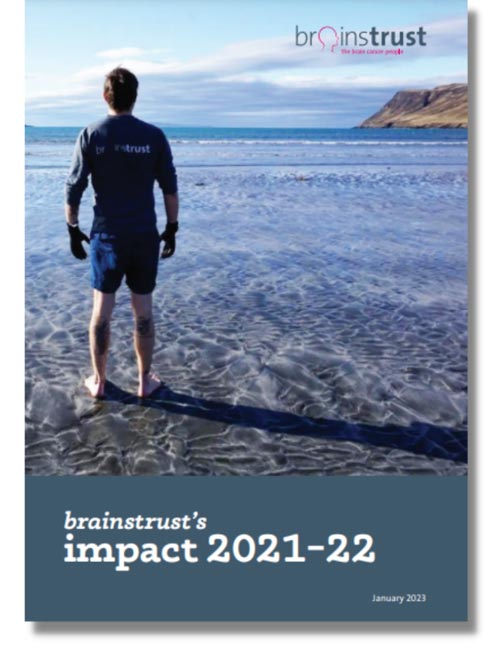Our story
2006
brainstrust is founded by Helen and Peter Bulbeck with the goal of helping Megan Hill (nee Jones) and others like her to access intra-operative MRI brain surgery in the United States.
brainstrust is registered with the Charity Commission.
2007
June 2007, Meg’s tumour is successfully removed at Boston’s Brigham and Women’s Hospital
With it now apparent that there is no effective support available for people with a brain tumour, brainstrust’s board of Trustees decide to expan, re-investing a small surplus of funds so that people don’t have to feel as lost as Meg’s family did, from the point of a brain tumour diagnosis.
2008
brainstrust’s volunteer team expands to include one full time member of staff.
2009
Work begins on our first patient and carer resources – the ‘Who’s who guide’, ‘brain book’ and 'brain box’.
brainstrust.org.uk is re-launched, with a new focus on providing online information and support for people with a brain tumour and their carers.
2010
The first brainstrust Meet Up is held in Winchester.
The brain box is launched – a groundbreaking toolkit, free for people with a brain tumour that helps them manage the complicated and confusing journey from when you are diagnosed.
The Rank Foundation commit to 3 year funding of the UK’s first brain tumour support specialist. The first step towards making 24/7 coaching led support available to the whole of the UK brain tumour community.
2011
Work starts on the Brain Tumour Patient Information Portal – a project to help people with a brain tumour understand their condition better by granting online access to National Cancer Registry held records.
www.braintumourhub.org.uk is launched, with funding from the Nominet Trust, to help patients and carers access support in their area, and clinical trials relevant to their tumour type.
Our information for people with a brain tumour is awarded NHS England’s Information Standard Accreditation.
2012
Work with Edinburgh Cancer Centre, the University of California, San Francisco and Coventry University demonstrates the positive impact of coaching for brain tumour patients.
brainstrust join forces with Cancer Research UK to make the Patient Information Portal available to all cancer patients.
brainstrust’s board of Trustees are awarded ‘Trustee board of the year’ at the Wessex Charity Awards.
brainstrust opens dedicated counselling service for the brain tumour community.
2013
Working with Public Health England’s National Cancer Registration Service, we identify, for the first time, the number of people living with a brain tumour in England.
Julian Fellowes shows his support for our work, joining us for dinner at Knightsbridge Barracks and raising £20,000 in the process.
The acclaimed brain tumour patient guide is launched.
Wear Grey attracts 10,000 people and raises £7,000.
Recognising a need for better support for children and families affected by a brain tumour, brainstrust launches ‘little brainstrust’.
brainstrust secures relationships that improve access to hypnotherapy for people with a brain tumour.
brainstrust’s ‘Northern’ offer is established in Sheffield with an overdue expansion of the team.
www.braintumourawareness.org.uk is launched to drive awarness of the real issues faced everyday by people with a brain tumour.
2014
brainstrust secures official registered Charity status in Scotland.
The Rank Foundation commits to 3 years funding for an additional support specialist and volunteer led programme in the North of England.
‘Walk a mile’ - guide for carers published.
The Brain Tumour Patient Information Portal is shortlisted for a Quality in Care Oncology award.
brainstrust and partners launch the first national brain tumour tissue bank is launched.
2015
brainstrust launches a 5 year vision for a service to help all of the 60,000 plus people in the UK living with a brain tumour, and their carers.
The brain tumour tissue campaign is launched in a bid to improve consent levels.
The brain tumour patient guide is cited as an example of best practice of how to communicate information to patients and carers clearly.
Our policy arm is launched to the public, setting out our agenda and plans for putting the world right, the right way, for people with a brain tumour.
We celebrate our 100th Meet Up, and 500 registered members of the brainstrust Meet Up community.
brainstrust receives a ‘Charity Comms Inspiring Communicator of the year’ award.
Wear Grey raises £30,000 for brain tumour support.
Brain tumour support given due prominence for the first time at the BNOS conference as brainstrust is invited to deliver closing plenary.
brainstrust’s response to the question posed on BBC Radio 2’s Jeremy Vine show ‘is there such a thing as a benign brain tumour?’ receives overwhelming support.
The Patient Information Portal project wins top prize at the NCIN conference in Belfast.
The brainstrust brain tumour support community on facebook reaches 1000 members.
2016
brainstrust celebrates 10 years of brain tumour support.
We publish the first dedicated guide for brain tumour patients undergoing radiotherapy.
A milestone for brain tumour support as brainstrust’s strategy for steady, sustainable growth sees annual funds raised for brain tumour support exceeding £0.5m for the first time.
Four new Little White Books are launched, signposting people to the help available in Merseyside, London, South East Scotland and Glasgow.
2017
brainstrust joins the Tessa Jowell Brain Cancer Mission. The mission consists of passionate academics, doctors, members of cancer charities, patients, and other individuals to help facilitate a new national strategy for brain tumours. The mission serves as a convening body for these organisations, enabling them to work together to make a tangible change in brain tumour treatment and research.
We join the #callforclarity campaign, to promote robust and rigorous impact reporting internally and across the charity sector. Alongside this we begin our own journey to take our impact reporting beyond counting beneficiaries and anecdotal testimony, working closely with the National Lottery Community Fund.
The Fatigue programme is launched, with resources to help our community cope with and tackle the debilitating Fatigue that accompanies brain tumour treatment. 316 people access this arm of our service in the first 6 months.
We hold the first UK Brain Tumour Symposium in Milton Keynes in collaboration with Brain Tumour Research. The event sold out in 48 hours.
2018
799 new people accessing phone and email support (up 58% on 2017 – 507/799) , accompanied by the rollout of the brainstrust progress tracker to evaluate the progress that these people make with brainstrust’s coaching and support.
Follow the Seagulls treks expand to Fife, our first year with 3 concurrent 50 mile walks, raising a total of £43,000 for our work.
Collaboration with the James Lind Alliance Priority Setting Partnership (JLA PSP) continues with brainstrust running workshops to develop key research questions around the 10 priorities for brain tumour research as identified by the PSP.
With Public Health England and the National Cancer Registration and Analysis Service, we launch the brain tumour data dashboard, giving unprecedented access to registry held data in an easy to understand format. It helps people understand questions like ‘how many people have a brain tumour like me, near me?’ And ‘how many people like me have brain tumour surgery?’.
First Scottish Symposium held in Glasgow to close the information gap for the brain tumour community and establish a collaborative network in Scotland of charities, healthcare professionals, patients and caregivers.
91% leap in demand for brain boxes (431/824), prompting the first ‘brain box appeal’ which raises £21,000.
Siemens Healthineers nominates brainstrust as charity of the year.
2019
We are able to directly support and coach over 1000 people in 12 months for the first time.
Brain tumour ‘know hows’ launched offering bite sized overviews of vital topics including Proton Therapy, vaccine treatments and cannabinoids.
Follow the Seagulls expands to include a 50 mile trek in Devon and raises a record £70,000.
brainstrust selected to represent patients and caregivers on the NHS England review of the brain tumour patient pathway.
‘First, we are people’ - our new strategy is launched and taking into account all that we’ve learned over the previous 14 years, puts laser focus on the human, practical and cultural contexts in which people find themselves following a brain tumour diagnosis. It sets out our journey to help these people become less isolated, more in control, more engaged with their clinical care and condition, and better resourced.









